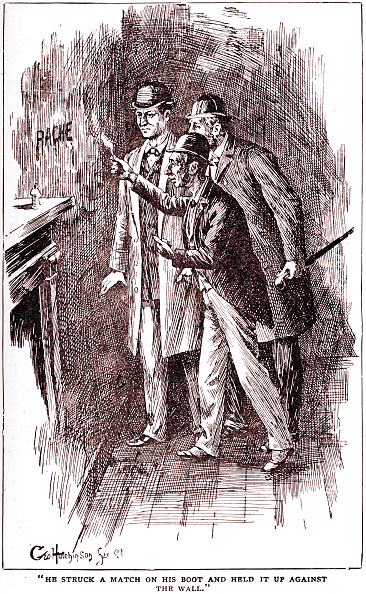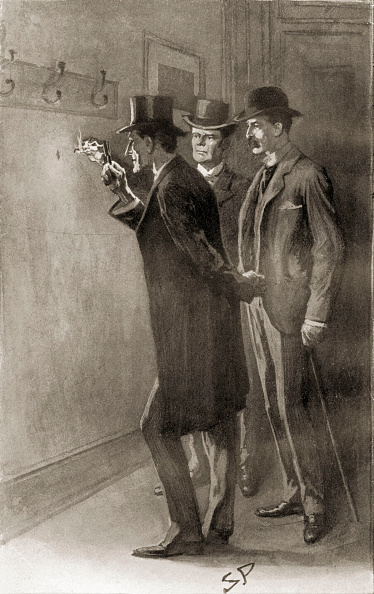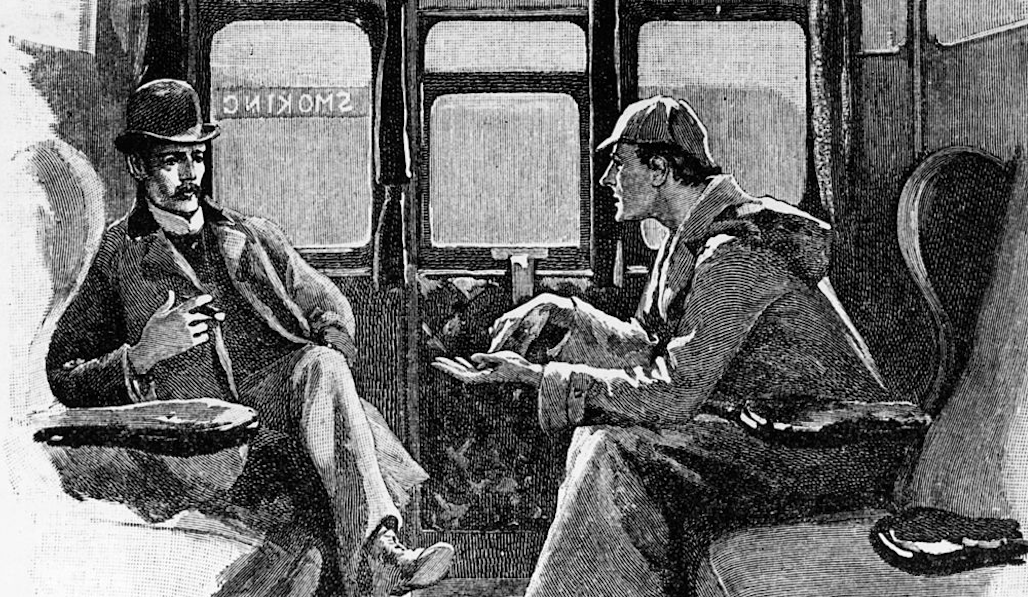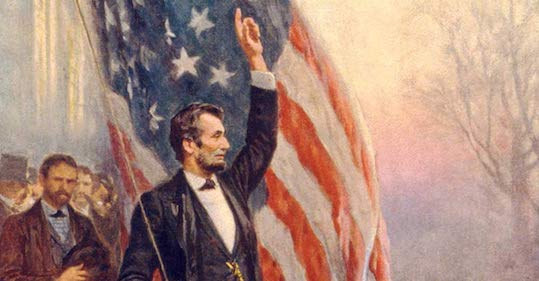
Over the course of 40 years during the late 19th and early 20th century, Arthur Conan Doyle published 60 Sherlock Holmes tales in the form of four short novels and 56 short stories (which are generally published in five separate collections). The adventures of Doyle’s iconic detective proved a craze from the start, and since then, no character has been as reproduced and adapted in film, television, stage, and the printed word.
I’d long been intrigued by the idea of Sherlock, but wasn’t really spurred into reading the stories until we had Michael Sims on the podcast to talk about Arthur Conan Doyle and the creation of his archetypal sleuth. I started with the first published novel, A Study in Scarlet, and quickly enough got through the other 59 stories too. I was immediately entranced by not only the mysteries, but also the characters. Watson’s devotion to and trust in Sherlock is admirable; Sherlock’s reluctant reliance on Watson’s companionship is heart-warming. Though Doyle peppers in just a couple new personal details with each tale, over the course of the stories the personalities of these protagonists are rounded out more than you’d perhaps expect.

Some of the entries in the series are definitely better than others; for one thing, the final two published collections, His Last Bow and The Case Book of Sherlock Holmes, are universally regarded as lesser material. So while it’s certainly not a waste of time to read the entire canon — you may get so attached to the characters that you can’t help but do otherwise! — if you’d like to jump into a more curated set of suggestions, below you’ll find my favorite 10 tales: two novels and eight stories pulled from the first three short story collections.
Most every story (outside of those in The Case Book) is in the public domain; click the title of each to read them for free online!
A Study in Scarlet

For any new reader of Sherlock, A Study in Scarlet is undoubtedly the place to start. There could be no better introduction than the blind meeting of Mr. Holmes, amateur sleuth, and his new roommate, Dr. John Watson. They quickly learn about each other: Watson is neat, curious, good at his work, but generally unremarkable. (Though he provides Holmes his much-needed flattery.) Sherlock is utterly brilliant when it comes to detective work, but ignorant of most other subjects. He can be cold, aloof, and spectacularly arrogant, though very rarely in a vindictive way. Watson, perhaps surprisingly to the new Sherlockian, is pretty quickly revealed as the more likable fellow.
The first case that Watson records involves a murder in an abandoned house with “RACHE” written on the wall. Scotland Yard investigator Lestrade (we never learn his first name) invites Holmes to consult on the case; though the budding detective initially feigns reluctance, his intellect won’t let him turn down the chance to solve a mystery.
Contained within the tale are numerous examples of Holmes’ classic methodology, which relies less on the mistakes of the criminals — as had largely been the case in earlier detective fiction — than on the investigator’s supreme wits and inductive reasoning skills. Across the entire canon, it’s not that the criminals are dumb; it’s that Holmes is smarter.
From the numerous twists and turns, to a fun trip to America’s Western frontier, to the delightful construction of the characters’ charms and personalities, and finally to the unforgettable conclusion, I can’t think of a better introduction to a detective series than A Study in Scarlet.
The Hound of Baskervilles

While A Study in Scarlet serves as a great introduction to Holmes and Watson, no story itself is as well done as The Hound of Baskervilles. Using the length of a novel rather than just a short story, and without the need for much expository ramp-up, Conan Doyle is able to fully explore the depths of the most head-scratching case in the series.
Sir Charles Baskerville is found dead near his manor in the craggy moors of southern England. There’s no outward evidence of murder, but there are suspicious signs, including the frozen look of horror on Baskerville’s face. There aren’t many clues to work from, except for an old legend about a monstrous hound that has attacked Baskerville heirs for generations.
Part of the fun of this story are the various writing devices — between firsthand accounts, journal entries, and Watson’s dispatches to Holmes, the reader slowly begins to piece together what’s going on. But, of course, only Holmes himself can place the final piece of the puzzle.
Could the solution really lie in the supernatural? You’ll have to read the tale.
“The Red-Headed League”
Now we enter the realm of the short story. Jabez Wilson, a man with flaming red hair, consults with Holmes about a mysterious job he took in reply to a want ad in the newspaper. Placed by “THE RED-HEADED LEAGUE,” it announced that “All red-headed men who are sound in body and mind and above the age of twenty-one years” were eligible for a well-paying but non-descript job.
Wilson showed up for the interview, was declared to have just the right hue of red in his locks, and was set to work copying the encyclopedia. After getting through the “A’s,” he returned to the office only to see a sign on the door which read “THE RED-HEADED LEAGUE IS DISSOLVED.”
What’s going on? Surely there’s more to these strange circumstances than meets the eye. Only Holmes can solve such a riddle. With this story, Doyle shows the fun, playful side of his mystery-writing chops.
“The Final Problem”

Though he takes a central role in only this one story (he’s reminisced about in others), no Sherlockian villain is as nefarious as Professor James Moriarty; “He is the Napoleon of crime,” Sherlock tells Watson. “He is the organizer of half that is evil and of nearly all that is undetected in this great city. He is a genius, a philosopher, an abstract thinker. He has a brain of the first order.”
Holmes has been tracking him and his gang for some time and is on the verge of putting all of them away. But when Moriarty discovers who’s on his tail, the tables are turned and Holmes and Watson end up on the run themselves. Can they escape the grips of this heartless monster?
The end of this story nearly caused riots in London when it was published.
Bonus: You should definitely read “The Adventure of the Empty House” right after finishing this one.
“The Adventure of Silver Blaze”

On the eve of an important horse race, a prized thoroughbred, Silver Blaze, has gone missing, his trainer has been murdered, and some sheep in a nearby pasture have been found lame. Will the horse be found in time for the race? Will the trainer’s murderer be found? What about those dang sheep?
There are a couple different threads here which feature some of Doyle’s finest and most memorable writing and reasoning. The famous exchange about “the curious incident of the dog in the night-time” in fact inspired an excellent novel which used that line as the title.
Some of the better-written Holmes stories are somewhat predictable, and some of the better plot lines aren’t as well written or structured; “The Silver Blaze” is one of those that combines all the best elements of Doyle’s work.
“The Adventure of the Copper Beeches”

The beauty of the Sherlock Holmes stories is that you’re sure to find one with a tone that appeals to you; there’s quite a range on a scale that runs from fun and playful to dark and twisted. This story falls on that latter end of things and offers a darker glimpse into Doyle’s mind than we get in most of the other stories. That said, it’s not so twisted as to be off-putting, and, spoiler alert, there’s ultimately a happy ending.
The charming Miss Violet Hunter visits Holmes and asks his opinion on taking a job as a nanny which, though it pays well, also comes with a number of peculiar conditions, including cutting her hair short and wearing particular clothes. She takes the job, but as things in the house get stranger and stranger, she calls on Holmes to come help her out. The riddle turns out to be more far-reaching and twisted than either Holmes or Watson thought possible.
“A Scandal in Bohemia”
This is another of Doyle’s more playful stories and involves the most memorable female character of the entire series; in Sherlock’s eyes, “she eclipses and predominates the whole of her sex.”
On the eve of his marriage, the King of Bohemia needs help not with solving a crime, but in simply keeping an old affair on the hush-hush. In his youth, the king had a romp with an American opera singer named Irene Adler. During their relationship, the king sent her a large photograph of them together, which is still in her possession. Should Irene turn sour towards him, it could come out and embarrass the king’s pious fiancee.
Holmes takes the case, thinking it’ll be a piece of cake to trick the woman and retrieve the photograph. Turns out, Irene is quite a bit more cunning than Holmes initially suspects. With a number of disguises used on both sides, one of them finally and permanently gains the upper hand. But is it Adler or Holmes who wins the day?
“The Adventure of the Norwood Builder”

This story has as memorable a start as you’ll find in the canon: a young lawyer, John McFarlane, comes into Holmes’ office knowing full well he’s going to be arrested and charged with murder. The day before, McFarlane had been made the beneficiary in the will of one of his clients; later that evening, the client was violently bludgeoned to death and his body lit in flames to hide the evidence. Of course, all signs point to the guilt of McFarlane.
Inspector Lestrade holds McFarlane in custody for the time being, giving Holmes some time to prove his innocence before the young lawyer is charged. Can he do it?
It’s fun seeing Holmes have to work backwards from his usual methodology. We also see a fuller picture of Lestrade in this story; rather than just begrudging competition, the relationship between him and Holmes seems to flourish into real comradeship.
“The Adventure of Charles Augustus Milverton”
While Holmes always has justice in the eyes of the law as his primary pursuit, every once in a while a case comes up that challenges his ideas about right and wrong. The most memorable of those is the story of Charles Augustus Milverton. He’s a wealthy loner whose primary income comes from the business of blackmailing. He buys seedy letters and photographs and then sells them to whoever the highest bidder is, regardless of whose lives are destroyed in the process.
Holmes is enlisted in the fight against Milverton by Lady Eva Blackwell, who’s keen on retrieving some compromising documents. Milverton is as dastardly a fellow as London has ever seen, and though Holmes is aware of him, he hasn’t had the chance to nail down evidence of his breaking the law; this is his opportunity and he leaps at it. The reader gets the gift of clever disguises, a false engagement, breaking and entering, safe-cracking, and as surprising an ending as you’ll come across in these stories. It’s a delight.
Keep up with all my reading by subscribing to my bookish newsletter, “What to Read Next.”
Check out our podcast with Michael Sims about the origins of Sherlock Holmes:
Tags: Books




